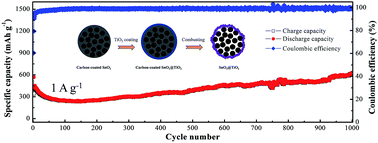Facile fabrication of SnO2@TiO2 core–shell structures as anode materials for lithium-ion batteries†
Abstract
A novel strategy to fabricate SnO2@TiO2 composite was developed by combining the glucose-mediated hydrothermal method along with a sol–gel step, followed by a sintering process. Herein, glucose was found to play dual roles of facilitating the rapid precipitation of polycrystalline SnO2 nanocolloids in the hydrothermal process and act as a pore-forming material to leave behind nanopores when it is combusted in the sintering process. Due to the combined superiority of TiO2 as a inert nanoshell and SnO2 as a core with a high theoretical specific capacity, together with the combustion-formed carbon-derived voids with many extra free spaces to buffer the volume change, the obtained SnO2@TiO2 composite has potential for use as an anode material for lithium-ion batteries with enhanced electrochemical performances. A high reversible capacity of 910 mA h g−1 was maintained over 300 cycles at a current density of 100 mA g−1. Even at a high current density of 1000 mA g−1, the substantial discharge capacity could still reach 617 mA h g−1 after 1000 repeated cycles. Such excellent cycling stability and remarkable rate capability of the designed SnO2@TiO2 composite can be attributed to its novel structure and the synergistic effects between the SnO2 core and TiO2 shell.


 Please wait while we load your content...
Please wait while we load your content...